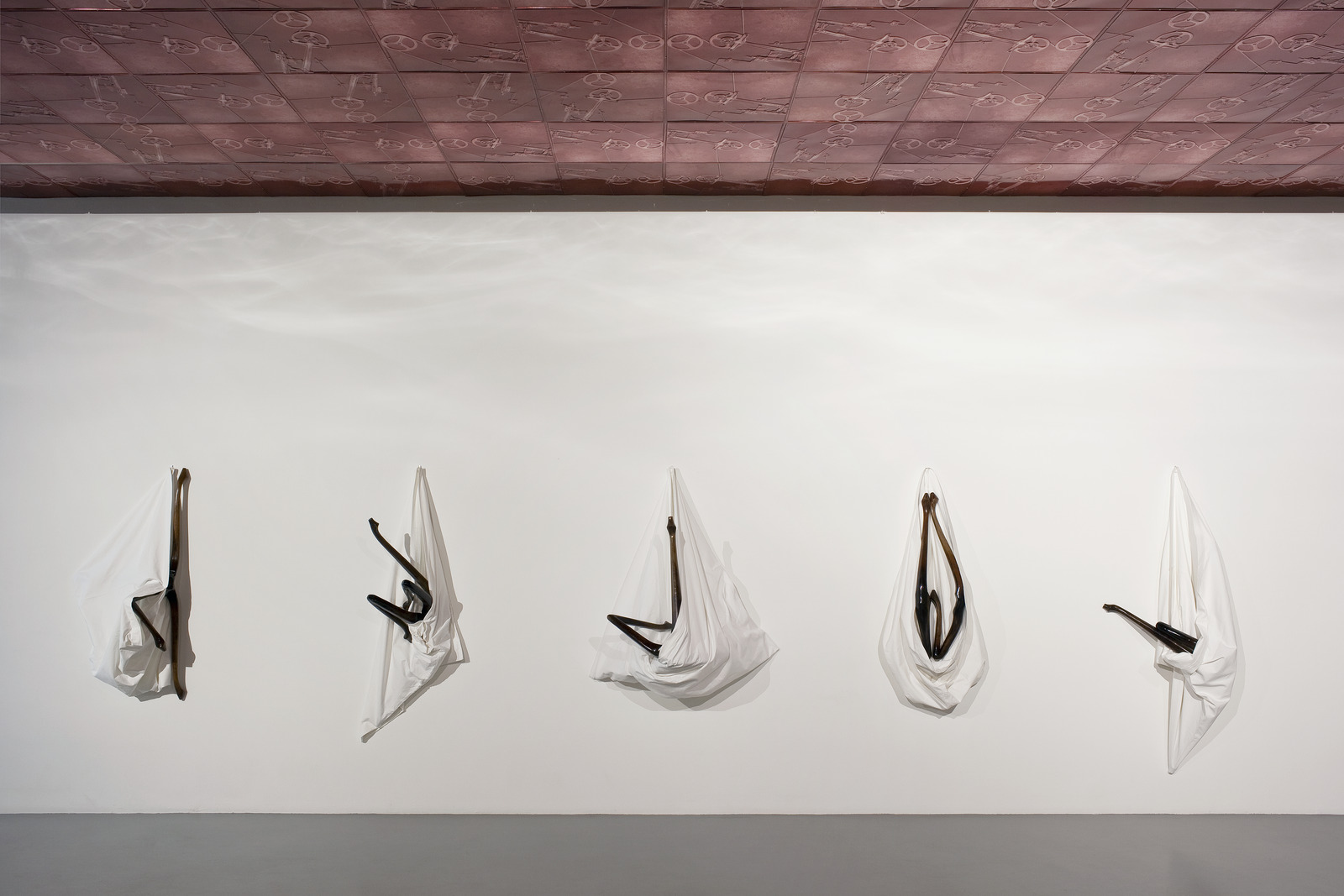Artist: Markus Schinwald
Venue: Giò Marconi, Milan, Italy
Date: March 30 – May 20, 2017
Photography: images copyright and courtesy of the artist and Giò Marconi, Milan
Gió Marconi is very pleased to announce his fourth solo show with Austrian artist Markus Schinwald.
Based on interests ranging from psychology and literature to dance and the history of fashion, Schinwald explores the idea of the human body as a cultural construct. Schinwald’s artistic repertoire consists of splayed table leg sculptures, distorted 19th century portraits, marionettes, films without beginning or end and site-specific installations.
His art gives form to the psyche and its tensions and creates a mysterious and unsettling atmosphere that hints at its Viennese production context through references to decorative Biedermeier style or psychoanalysis. He concentrates on processes of manipulation and alteration of bodies and their surroundings through spatial works and architectural interventions.
In 2011, Markus Schinwald represented Austria at the 54th Venice Biennial with an installation that architecturally played with the existing space. Inside the Austrian pavilion Schinwald had constructed a mazy wall structure of suspended walls that opened the view onto other people’s legs therewith incorporating the visitors into the installation and making them protagonists.
The exhibition at Gió Marconi also plays with the gallery’s architecture and consists of two corresponding architectural works.
Upon entering the exhibition space the viewer walks towards a long row of nine canvas sack sculptures – all hung in a single file along one wall of the gallery, each filled with arrangements of Chippendale-legs, some splayed, some demure.
In his sculptural practice Schinwald has always been interested in the manipulation of pieces of furniture. He often uses Biedermeier table or chair legs, characteristic of a 19th-Century style. He saws them off and rearranges them in uncanny ways that bring out their anthropomorphic qualities. The half-hidden wooden parts stretch the fabric, which is reminiscent of the white cloth that is used to cover and protect furniture, thus creating weird and sexually allusive forms. The stretched fabric acts as both sling and cocoon, concealing joints and limbs that struggle as much as they acquiesce.
Besides the row of sacks Schinwald also intervenes with the actual gallery space: The jigsaw-like assembly of large, interlocking metal panels that extend across the ceiling, are embossed with a pattern that creates the impression of a complex, suspended machine, a kind of exposed mechanical viscera. The metal mimics the bas relief gesture of Rococo stucco, curving and extending overhead, blanketing the entire space in a mildly aggressive red sheen and giving the whole show a slightly erotic touch.
In transforming the white gallery ceiling into a red tiled artwork Schinwald bestows a completely different atmosphere upon the room and makes a Gesamtkunstwerk of the space.
At the entrance of the gallery, the ‘Jubelhemd’ is displayed. One of Schinwald’s earliest works, is a fabric piece inspired by the tailored shirts worn by orchestral conductors. The altered arms force the wearer to keep their arms raised, a gesture that evokes both celebration and capitulation. Though the ‘Jubelhemd’ is celebrating its 20th anniversary, its ambivalent extremes seem particularly relevant in today’s political climate
Markus Schinwald (b.1973 Salzburg) lives and works in Vienna and New York.
He has been featured in solo and group exhibitions internationally at institutions including: “Markus Schinwald” Magasin III, Stockholm, Sweden (2015); “Il dissoluto punito”, La Triennale di Milano, Milan, Italy (2014); “Markus Schinwald”, M Museum Leuven, Leuven, Belgium (2014); “Ouverture”, Palais de Tokyo, Paris, France (2013); 54th Venice Biennale, Austrian Pavilion, Venice, Italy (2011); Migros Museum, Zurich, Switzerland (2008).
Marku Schinwald’s work is part of major collections, such as: Museum of Modern Art MUMOK, Vienna, Austria; Belvedere Museum, Vienna, Austria; Musée d’Art moderne, Paris, France; Kunsthaus Zürich, Switzerland; Migros Museum für Gegenwartskunst, Zurich, Switzerland; Tate Modern, London.
Markus Schinwald, Jubelhemd, 1997, Textile, 100 x 130 cm, 134 x 154.2 x 5 cm (framed)
Markus Schinwald, Lea, 2017, Oil on canvas, Ca. 40.7 x 26 x 2 cm, 43 x 29.4 x 3.7 cm (framed)
Markus Schinwald, Plafond, 2017, 50 embossed panels, Each: 60 x 60 cm
Markus Schinwald, Plafond, 2017, 50 embossed panels, Each: 60 x 60 cm
Markus Schinwald, Plafond, 2017, 50 embossed panels, Each: 60 x 60 cm
Markus Schinwald, Sacks #12, 2016, Textile, wood, Ca. 135 x 66 x 47 cm
Markus Schinwald, Sacks #13, 2016, Textile, wood, Ca. 160 x 59 x 45.5 cm
Markus Schinwald, Sacks #14, 2016, Textile, wood, Ca. 132.5 x 110 x 62 cm
Markus Schinwald, Sacks #15, 2016, Textile, wood, Ca. 137.5 x 56 x 36 cm
Markus Schinwald, Sacks #16, 2016, Textile, wood, Ca. 177 x 70 x 35 cm
Markus Schinwald, Sacks #17, 2017, Textile, wood, Ca. 136 x 67 x 73 cm
Markus Schinwald, Sacks #18, 2017, Textile, wood, Ca. 134.5 x 118 x 25.5 cm
Markus Schinwald, Sacks #19, 2017, Textile, wood, Ca. 133.5 x 88.5 x 43 cm
Markus Schinwald, Sacks #20, 2017, Textile, wood, Ca. 154.5 x 85 x 48.5 cm
Markus Schinwald, Sacks #21, 2017, Textile, wood, Ca. 161 x 70 x 33 cm





























